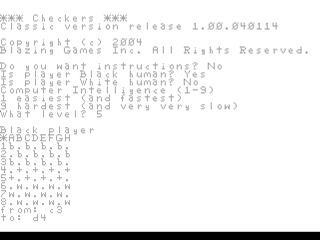

For more information about the site shutdown, click here. To see the current standings of games (in order of popular vote) click here.
Note that all episodes of this series are grouped together so voting forone is the same as voting for all episoded.
![]() Blazing Games - Ultimate Retro Project - Volume 3 - Episode 27
Blazing Games - Ultimate Retro Project - Volume 3 - Episode 27
Ultimate Retro Project
Episode 27: Classic Checkers

The classic board game.
Page Last Updated: April 1, 2006
Introduction
Checkers is a very ancient game which most people have learned to play as children. While there are a few minor variations of the game, the basic game mechanics are simple enough. The version of the game presented here is the version I have always played. Some versions of the game force players to jump if they can. This is not one of those versions.
Using the Console
Creating text games is interesting, but my goal was also to present the game in a way that would simulate a teletype machine as close as possible. This is why the game uses my console.
My Teletype Emulator is designed to simulate playing the game on an old teletype machine, down to the dot matrix output. Anybody who has used an old printer knows how slow they were. They were also noisy, but out of the goodness of my heart, I decided to leave the noise out.
For getting input from the user, I decided to go with a fancy LCD model, in which what you type will be send to a LCD display for your approval before being transmitted to the machine. Unlike real machines, my terminal is intelligent and will only let you enter something when the program is requesting input. Any other typing is ignored!
Playing the Game
The goal of the game is to win by removing all the opponents pieces or by getting the opponent into a position where they are unable to make a move. Each turn the player must make a move by moving any piece one position diagonally towards the opponent’s side of the field. The space moved into must be empty. If the space you wish to move into is occupied by an opponent but the space after that space is empty, you may jump over the opponent. This results in that opponent piece being removed from the board. If after jumping the opponent, you are able to jump over another opponent, you may make multiple jumps (up to a maximum of 12 jumps).
If you reach the opponents end of the board, then your piece is kinged (represented by a capital letter)! A kinged piece is able to move in any of the four diagonals. If you became a king by jumping, it is still possible to continue jumping (if more jumps are available).
Making a move is simply a matter of specifying the coordinates of the piece you want to move followed by the location of where you want to move to. Coordinates are entered as a letter number pair. For example, H8 or A1. For jumps, specify the coordinate the piece will be in after the jump has been completed. For multiple jumps, specify the coordinates of the first jump, you will then be prompted for additional jumps.
System Requirements
This game is requires Java 1.1 or better to run. Browsers that support 1.1 tend to be 4.x or better versions. Windows XP users may have to download a Java plug in to use Java applets.
Clicking on the link below indicates that you agree to the disclaimer (click here to read).
PLAY Classic Checkers
Please note that the above links open in a new window. Popup blocking software may not allow this so read the popup blocker's instructions for allowing this (unless you are also running ad blocking software, in which case please don't play the game as it costs money [made by the advertising] to keep this site running).
Back to Ultimate Retro Project volume 3 Index
About -
Privacy Policy -
Contact -
Links -
FAQ
Copyright © 2004-2006 Blazing Games Inc. All Rights Reserved.
